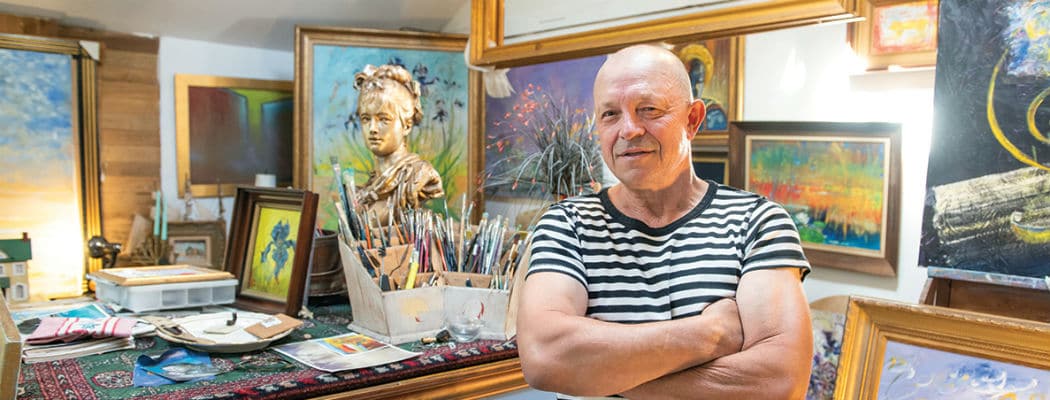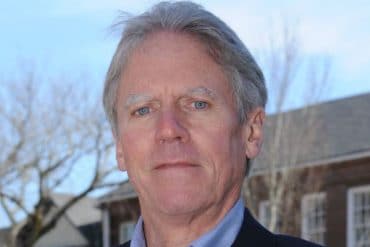One local artist’s unbelievable journey to freedom.
Eighteen years ago, Nantucket resident Paul Galschneider was sitting in a maximum-security prison cell giving Steve “The Rifle-man” Flemmi a foot massage. He was befriended by the legendary mobster of Whitey Bulger’s Winter Hill Gang on his very first day on H3-Block in Plymouth County Correctional Facility. All the big-time gangsters like “Cadillac” Frank Salemme and Bobby DeLuca were on that block. But Galschneider had no idea who these convicted murderers were, so when Stephen Flemmi asked him to be his cellmate, Galschneider agreed.
F or the better part of eighteen months, Galschneider lived in an eight-by-fourteen-foot cell with one of the most notorious gangsters in American history. Although they had little in common, the two became inseparable friends. “It’s hard for me to believe all the horrible things they say he did,” Galschneider says. “Stevie was a good friend to me.”
or the better part of eighteen months, Galschneider lived in an eight-by-fourteen-foot cell with one of the most notorious gangsters in American history. Although they had little in common, the two became inseparable friends. “It’s hard for me to believe all the horrible things they say he did,” Galschneider says. “Stevie was a good friend to me.”
So what landed this Nantucket resident behind bars with drug dealers, convicted murderers and mob bosses? It’s an immigrant story that begins a world away, in a country that no longer exists.
Paul Galschneider was born in Czechoslovakia during the Cold War. At the age of ten, his parents decided to move to Austria where his mother was born and still had family. In 1967, they applied for a permit that would legally allow the family to go back and forth between the two neighboring countries. A year later, the Prague Spring broke out, prompting the Soviet Union to invade Czechoslovakia and seize control. While many Czechoslovakians fled into Austria amidst the tumult, Galschneider said his family stayed behind, determined to obtain a permit from the government to legally leave the country, which they received a year later.
 Living in his mother’s native Austria, Galschneider taught himself to speak German and became a plumber. He eventually married and had a child. He was still legally a citizen of Czechoslovakia and often returned to see friends and family, but with each visit home, he saw how the grips of communism were getting tighter and tighter. “There was no freedom there,” he remembers. “It was a police state. They were arresting people at will.” After he was detained under suspicion of smuggling people out of Czechoslovakia and into Austria — which today he admits to doing — Galschneider realized his native country was no longer his home. With that, he turned his sights to the West.
Living in his mother’s native Austria, Galschneider taught himself to speak German and became a plumber. He eventually married and had a child. He was still legally a citizen of Czechoslovakia and often returned to see friends and family, but with each visit home, he saw how the grips of communism were getting tighter and tighter. “There was no freedom there,” he remembers. “It was a police state. They were arresting people at will.” After he was detained under suspicion of smuggling people out of Czechoslovakia and into Austria — which today he admits to doing — Galschneider realized his native country was no longer his home. With that, he turned his sights to the West.
“America was always a dream for me,” he says. “Tom Sawyer and Huckleberry Finn, cowboys and Indians — I watched everything about America on television.” In 1985, Galschneider arrived in Boston with his wife and young daughter on a ninety-day vacation visa. He checked into a hotel and called one of the only other Czechoslovakians he knew living in the United States, Robert Hutyura. Hutyura was arguably the most famous Czechoslovakian in the world at the time. He had become an international news sensation after escaping Czechoslovakia with his wife and two children in a hot air balloon that he created out of rubber raincoats. After landing safely in Austria, Hutyura had been interviewed by Germany’s biggest magazine, and Paul Galschneider was his translator. Hutyura was now living in Boulder, Colorado and told Galschneider to bring his family west.
 Within weeks of moving to Boulder, Galschneider said he hired a lawyer and applied for political asylum from the communist police state that was now Czechoslovakia. He loved the United States and wanted to stay. But his application befuddled American immigration officers. His passport indicated that he was a legal citizen of Czechoslovakia, but he also had that permit to live in Austria. Why wouldn’t he just live in Austria? The confusion landed Galschneider’s asylum application in limbo.
Within weeks of moving to Boulder, Galschneider said he hired a lawyer and applied for political asylum from the communist police state that was now Czechoslovakia. He loved the United States and wanted to stay. But his application befuddled American immigration officers. His passport indicated that he was a legal citizen of Czechoslovakia, but he also had that permit to live in Austria. Why wouldn’t he just live in Austria? The confusion landed Galschneider’s asylum application in limbo.
Over the next six years while his application lingered, Galschneider pin-balled around the United States, from Boulder to New Jersey to New Bedford to eventually Nantucket. He registered as a documented foreigner, received a social security card and began paying taxes. On Nantucket, he bought a home just outside of town and built an art studio in his backyard. During his time in the United States, Galschneider not only taught himself how to speak English, but also how to paint. Despite having no formal training, his impressionist works sold for hundreds and then thousands of dollars.
 But over those years, Galschneider’s personal life also hit some rough patches. He and his first wife divorced, and Galschneider remarried two other times. When his third marriage began to fall apart, he moved out of his house and into the attic space in his art studio. His wife filed a restraining order against him. According to the Cape Cod Times, she said he had a “violent temper” and the two became embroiled in an ugly divorce proceeding. The situation got progressively worse when Galschneider sought to buy their house on Nantucket from her. Instead of negotiating a price with him, Galschneider says his wife called immigration on him. She denied these claims in the Cape Cod Times.
But over those years, Galschneider’s personal life also hit some rough patches. He and his first wife divorced, and Galschneider remarried two other times. When his third marriage began to fall apart, he moved out of his house and into the attic space in his art studio. His wife filed a restraining order against him. According to the Cape Cod Times, she said he had a “violent temper” and the two became embroiled in an ugly divorce proceeding. The situation got progressively worse when Galschneider sought to buy their house on Nantucket from her. Instead of negotiating a price with him, Galschneider says his wife called immigration on him. She denied these claims in the Cape Cod Times.
In April of 1999, Galschneider was swarmed by immigration officers on Nantucket. They cuffed him and sent him to Boston for deportation. He insisted that his application for asylum was pending, but INS informed him that his application had been denied years earlier. He never received the notification because he had moved around the country so often. When he got married, he also failed to file for a Green Card. Deportation would be his fate, the INS officials said.
 There was just one big problem with deporting Galschneider back to his homeland of Czechoslovakia — the country no longer existed. At the end of the Cold War, Czechoslovakia dissolved, splitting into the Czech Republic and Slovakia. This left the US Immigration office with nowhere to deport Galschneider. Instead, he was held in a maximum-security prison without trial until the immigration court could decide what to do with him.
There was just one big problem with deporting Galschneider back to his homeland of Czechoslovakia — the country no longer existed. At the end of the Cold War, Czechoslovakia dissolved, splitting into the Czech Republic and Slovakia. This left the US Immigration office with nowhere to deport Galschneider. Instead, he was held in a maximum-security prison without trial until the immigration court could decide what to do with him.
News of Galschneider’s imprisonment sent shock waves through the Nantucket community, of which he had become a beloved member. Letters from residents, including from the sheriff, were sent to the judge pleading for his release. Galschneider’s story landed on the front page of the Inquirer & Mirror, the Boston Globe’s Metro section and a number of other publications. Despite this public outcry, he remained in prison.
“There is nothing worse than being an innocent man in prison,” he says. Although he hadn’t committed a violent crime, Galschneider was locked up amongst the worst of the worst. “I think they do that intentionally,” he says. “Like they’re saying, if you don’t want to go to your own country, you have to live with these people.”
 So it was that Galschneider became friends and cellmates with Steve “The Rifleman” Flemmi. They spent every day together, doing hundreds of pushups and reading the Bible to one another. When Galschneider noticed that Flemmi was suffering from a foot ailment, he offered to try and fix it with reflexology. “After a few treatments working on his feet, the problem went away,” Galschneider says. “I remember Stevie looking up from his bottom bunk and saying, ‘Pavel, you’re a genius.’”
So it was that Galschneider became friends and cellmates with Steve “The Rifleman” Flemmi. They spent every day together, doing hundreds of pushups and reading the Bible to one another. When Galschneider noticed that Flemmi was suffering from a foot ailment, he offered to try and fix it with reflexology. “After a few treatments working on his feet, the problem went away,” Galschneider says. “I remember Stevie looking up from his bottom bunk and saying, ‘Pavel, you’re a genius.’”
Months dropped off the calendar and Galschneider’s hope began to wane. Unbeknownst to him, his immigration case had fallen through the cracks. He was now one of the many illegal aliens waiting years in prison for deportation — without ever going before a judge. After eighteen months in prison, Galschneider’s then-girlfriend on Nantucket hired a top immigration lawyer in Boston named Howard Silverman. Silverman took one look at the case and realized that Galschneider had been forgotten by the system. Within two weeks, Silverman had Galschneider out a free man.
 For the past eighteen years, Paul Galschneider has lived a quiet life on Nantucket. He eventually returned to his home on the island where he continues to paint in his studio. Now sixty-one years old, he has been in the United States for more than half his life and hopes to remain on Nantucket for the rest of his days.
For the past eighteen years, Paul Galschneider has lived a quiet life on Nantucket. He eventually returned to his home on the island where he continues to paint in his studio. Now sixty-one years old, he has been in the United States for more than half his life and hopes to remain on Nantucket for the rest of his days.
But recently his deportation case was reopened. Despite checking in with immigration every year, “sometimes twice a year,” Galschneider says President Trump’s new emphasis of deporting immigrants living in the country illegally has put him in INS’s crosshairs. When he learned about this, Galschneider started writing a letter each week to the White House pleading for President Trump to grant him asylum. A month ago, the White House responded with a letter indicating that they will review his case. Until he gets the final verdict, however, Paul Galschneider continues to live in fear as a man without a country.






